
02 Apr April Fool’s Day Campaigns: The Best and Worst Brand Pranks
April Fool’s Day is a golden opportunity for brands to showcase their creativity, humor, and—when done right—engage audiences in a memorable way. Over the years, some companies have nailed their pranks, boosting brand awareness and social media engagement. Others, however, have misfired, leaving customers confused or even frustrated.
Let’s take a look at some of the best and worst April 1st brand pranks—and what they reveal about what to do (and avoid) if your team’s ever planning one down the road.
What is an April Fool’s Day marketing campaign?
An April Fool’s Day campaign in digital marketing is a playful, time-bound content strategy where brands release humorous, satirical, or fictional announcements on April 1st. These campaigns aim to spark organic engagement, social sharing, and earned media coverage without heavily relying on ad spend. According to Hootsuite’s 2024 Social Trends Report, content with humor has 23% higher engagement rates than standard brand messaging.
Successful campaigns typically balance plausibility with absurdity and must ensure they don’t cross ethical lines. Unlike other holidays, April Fool’s is less about sales conversion and more about building cultural relevance, brand personality, and community bonds.
How to create a successful April Fool’s social media campaign?
To create a successful campaign, marketers should follow a three-step framework:
- Align with Audience Insights: Base pranks on customer behaviors, inside jokes, or shared trends (e.g., McDonald’s tapping into fries-and-milkshake culture in 2024).
- Produce High-Quality Content: Funny only works when it looks polished—mockups, videos, and branded visuals increase shareability by 64% compared to text-only jokes (Source: HubSpot 2025).
- Test Across Platforms: Roll campaigns across Facebook, Instagram, TikTok, and even email, since omnichannel execution drives 3–5x engagement increases on April Fool’s content (Ignite Social proprietary data, 2024).
The golden rule: keep jokes lighthearted, avoid sensitive topics like layoffs or bankruptcy, and ensure humor aligns with your brand voice.
Why does humor work in social media marketing?
Humor works because it humanizes brands, lowers audience resistance to engagement, and drives higher shares. Sprout Social’s 2024 study shows humor-driven content has 38% higher share rates than informative-only posts. When executed on April Fool’s Day, humor is contextualized—audiences expect playful content, making them more receptive.
Additionally, humor content helps algorithmic visibility. Meta confirmed in 2024 that posts receiving above-average reactions in the first three hours are prioritized in feed distribution. A creative prank can double early interactions, increasing organic reach without added spend.
When should brands launch April Fool’s Day campaigns?
Timing is critical. Campaigns should launch on April 1st itself, within early morning hours in targeted regions. Campaigns launched prematurely—as Volkswagen did in 2021 with “Voltswagen”—risk confusing press and damaging brand credibility.
Marketers should also consider audience activity cycles. According to Buffer’s 2024 posting research, posts between 8–11 a.m. local time have the highest April Fool’s Day interactions, ensuring pranks go viral before media saturation peaks later in the day.
Which brands executed the best April Fool’s Day campaigns?
 1. Google’s Endless Innovations
1. Google’s Endless Innovations
Google consistently tops the list with believable yet absurd product pranks. “Google Nose” introduced a fake scent-searching feature that some users genuinely tried.
Why It Worked: believable, trend-driven, non-disruptive. It reinforced Google’s innovative identity and earned global coverage.
2. AMGA’s Rebrand Parody (2023)
The American Mountain Guides Association parodied corporate jargon, announcing a fake rebrand full of buzzwords like “synergy” and “vertical integration.” It went viral across Facebook and Instagram, yielding a 4,490% spike in engagement.
 3. McDonald’s Shake Sauce Pots
3. McDonald’s Shake Sauce Pots
McDonald’s tapped into the fries-in-shakes trend, pitching fictional dipping sauces. The organic campaign reached over 9 million people, proving humor paired with real consumer behaviors fuels virality.
What are the worst examples of April Fool’s brand campaigns?
Tesla Bankruptcy Tweet (2018)
Tesla CEO Elon Musk joked about bankruptcy, which sparked panic and cost a 7% stock drop. Sensitive topics like finances disrupt trust and erode investor confidence.
 Volkswagen “Voltswagen” Rebrand (2021)
Volkswagen “Voltswagen” Rebrand (2021)
VW confused journalists by announcing a fake EV-driven rebrand days before April 1. Lack of humor cues and timing mistakes created negative press and consumer mistrust.
Bier Black Card Fail (2022)
Bier tricked customers into signing up for recurring beer payments under the guise of a prank. Regulatory bodies investigated, proving that deceptive financial pranks are not only unethical but also illegal.
What are the pros and cons of April Fool’s Day campaigns?
| Pros | Cons |
|---|---|
| Boosts brand awareness organically | Risk of confusing or misleading audiences |
| Reinforces brand personality | Negative financial or legal outcomes if mishandled |
| Drives virality without heavy ad spend | Short-lived results unless strategically repurposed |
7 best practices for April Fool’s social media marketing
- Anchor pranks in real customer behaviors.
- Launch only on April 1 and during optimal posting hours.
- Use high-quality execution (video, motion graphics, mockups).
- Deploy campaigns across multiple platforms for extended reach.
- Stay clear of finance, layoffs, or legal-sensitive jokes.
- Evaluate brand voice alignment—humor should complement your image.
- Measure success with reach, engagement, and sentiment tracking (rather than direct conversions).
How to measure success of April Fool’s campaigns on social media?
Metrics for April Fool’s campaigns differ from performance ads. Instead of conversions, marketers should focus on:
- Engagement Rate: likes, shares, and comments compared to standard weekly averages.
- Reach & Impressions: organic vs paid split (McDonald’s saw 89% organic reach in 2024).
- Sentiment Analysis: positive vs negative mentions to ensure brand humor is received well.
- Referral Traffic: track how many users visit your site from the prank post.
- Earned Media Mentions: PR wires, blogs, and influencer reshares that amplify reach at no cost.
Learn more about building content calendars that integrate seasonal campaigns.
Which tools are best for managing April Fool’s Day content?
Top tools for managing seasonal campaigns include:
- Hootsuite or Sprout Social: Scheduling and monitoring cross-platform responses.
- Canva or Adobe Express: Rapid prank mockups and shareable creative.
- Brandwatch: Sentiment tracking to detect backlash early.
- Google Trends: Identify what cultural references are peaking before execution.
- Ignite Social Analytics Dashboards: Proprietary benchmarking tool—proven to measure holiday campaign ROI more precisely (Ignite Social, 2024).
While April Fool’s has passed, there are still plenty of holiday’s to plan for. If you are ready to make your brand standout, contact us today.

